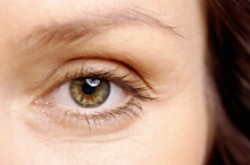Retinal Device Restores Sight in Mice
Retinal Device Restores Sight in Mice
Researchers have developed a new prosthetic technique that can restore vision to blind mice. The approach could potentially be further developed to improve sight in blind people.

More than 20 million people worldwide have vision loss or blindness because of retinal degenerative diseases such as age-related macular degeneration and retinitis pigmentosa. These diseases gradually damage photoreceptors, the light-detecting cells in the retina. Ganglion cells, which deliver signals to the brain for processing, are usually spared.
One promising approach to restoring lost vision is through prosthetic devices. Current prosthetics create a detour around damaged photoreceptors and directly stimulate ganglion cells, allowing patients to see spots of light and edges. This improves the ability to see light and shapes, but vision is still limited.
Recent research has focused on making the resolution, or image quality, better by stimulating more ganglion cells. These cells, however, have to be stimulated in a particular way so that they can change images into signal patterns the brain can understand. Current prosthetics don’t accurately mimic the same patterns of signals that the retina normally produces—the retinal code.
In research funded in part by NIH’s National Eye Institute (NEI), Dr. Sheila Nirenberg and postdoctoral researcher Dr. Chethan Pandarinath of Weill Cornell Medical College set out to design a prosthetic that generates an output more like a normal retina. They created a 3-part prosthetic system. The core innovation in the system is the encoder, which transforms images into electrical pulses. The electrical pulses are then converted into light pulses by a mini-projector. The light pulses stimulate light-sensitive proteins, which are inserted into ganglion cells through genetic engineering. The ganglion cells then forward these light-based patterns of signals to the brain. The researchers described their work online on August 13, 2012, in Proceedings of the National Academy of Sciences.
The scientists tested movies of natural scenes, such as landscapes, faces and people walking. They compared mice with normal sight to blind mice using the encoder prosthetic or a standard prosthetic. To test if their prosthetic was producing the normal retinal code, they placed electrodes next to ganglion cells in the mouse retina to measure their output.
Blind mice viewing movies through the encoder prosthetic produced output patterns similar to those of mice with normal sight. The output patterns of blind mice using the standard prosthetic were very different from normal. There was enough information in the encoder system’s output for the team to reconstruct a variety of images, including faces. The scientists also found that when the encoder and high-resolution stimulation were used in combination in blind mice, the animals were able to track images shown to them.
“What these findings show is that the critical ingredients for building a highly effective retinal prosthetic—the retina’s code and a high-resolution stimulating method—are now, to a large extent, in place,” says Nirenberg. Further study is needed before the retinal prosthetic could be tested in human clinical trials.
By Miranda Hanson, Ph.D.
###
* The above story is reprinted from materials provided by National Institutes of Health (NIH)
** The National Institutes of Health (NIH) , a part of the U.S. Department of Health and Human Services, is the nation’s medical research agency—making important discoveries that improve health and save lives. The National Institutes of Health is made up of 27 different components called Institutes and Centers. Each has its own specific research agenda. All but three of these components receive their funding directly from Congress, and administrate their own budgets.



















